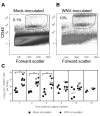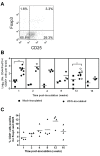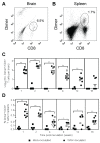Persistence of virus-specific immune responses in the central nervous system of mice after West Nile virus infection
- PMID: 21251256
- PMCID: PMC3031275
- DOI: 10.1186/1471-2172-12-6
Persistence of virus-specific immune responses in the central nervous system of mice after West Nile virus infection
Abstract
Background: West Nile virus (WNV) persists in humans and several animal models. We previously demonstrated that WNV persists in the central nervous system (CNS) of mice for up to 6 months post-inoculation. We hypothesized that the CNS immune response is ineffective in clearing the virus.
Results: Immunocompetent, adult mice were inoculated subcutaneously with WNV, and the CNS immune response was examined at 1, 2, 4, 8, 12 and 16 weeks post-inoculation (wpi). Characterization of lymphocyte phenotypes in the CNS revealed elevation of CD19+ B cells for 4 wpi, CD138 plasma cells at 12 wpi, and CD4+ and CD8+ T cells for at least 12 wpi. T cells recruited to the brain were activated, and regulatory T cells (Tregs) were present for at least 12 wpi. WNV-specific antibody secreting cells were detected in the brain from 2 to 16 wpi, and virus-specific CD8+ T cells directed against an immunodominant WNV epitope were detected in the brain from 1 to 16 wpi. Furthermore, these WNV-specific immune responses occurred in mice with and without acute clinical disease.
Conclusions: Virus-specific immune cells persist in the CNS of mice after WNV infection for up to 16 wpi.
Figures







References
Publication types
MeSH terms
Substances
Grants and funding
LinkOut - more resources
Full Text Sources
Medical
Research Materials

